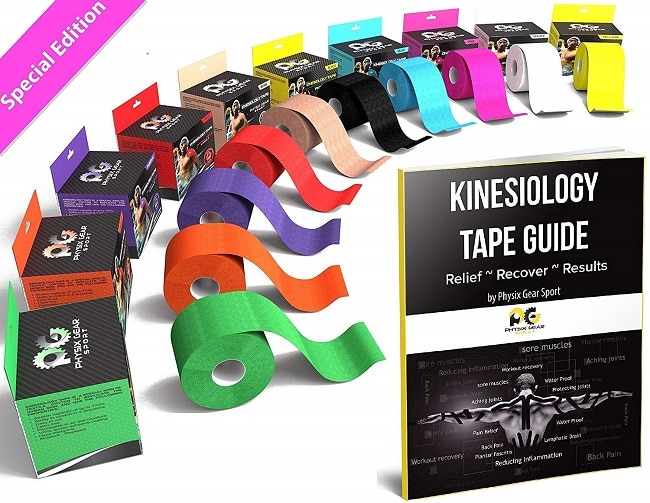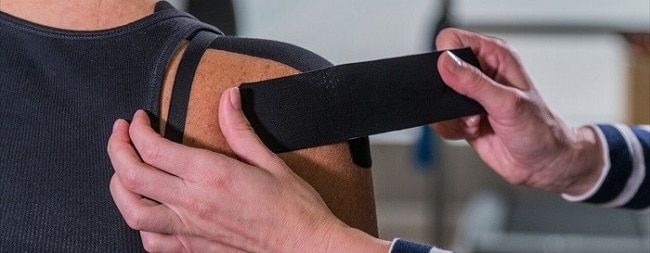Page Contents
by Ashley Smith
In contrast to customary athletic tape, which works by confining development and keeping muscles, ligaments tissues still, kinesiology tape works by enabling the zone around the muscle to remain adaptable, which thus is accepted to facilitate course to stream and speed mending. As opposed to just staying athletic tape on the sore and harmed territory, there is a technique for applying Kinesio tape accurately, and it originates from an all-encompassing practice known as kinesiology.
A lot of specialists approve of taping techniques for muscle pains since they have been known to relieve pain and to heal them, in effect. However, not all taping techniques are effective since some are said to worsen the situation instead of alleviating it, causing some doubts on some athletes to use taping techniques. Even though this is the case, a lot of people, especially athletes, still rely on them.
Kinesio taping was developed based on the premise that taping techniques should not hinder regular body movements even in the event of muscle injuries. This technique is called the Kinesio taping technique used in athletic circles as the Kinesio tape.
World-renowned athletes like Lauren Wenger (water polo), Tiger Woods (golf), Lance Armstrong (cycling), David Beckham (soccer), Kerri Walsh (beach volleyball), and Ari Taub (Greco-Roman wrestling) and a whole lot more prefer the Kinesio taping technique over any other taping techniques since they are able to give a lot more benefits than the traditional ones. That is because conventional taping methods are designed to restrict movement, not to promote it, that is why they are generally applied then removed after any activity done using it. The Kinesio tape, on the other hand, may still be used even after the action because of their water-resistant nature.
To date, the Kinesio taping method is found to be useful in a variety of ailments, from foot pain to headaches, and is continuing to receive a lot of praises. The main benefit that it provides it its ability to give stability and to maintain support to injured muscles and joints without affecting their range of motion and their circulation in any adverse manner.
Other additional benefits of the Kinesio taping method are:
- It is very economical since a roll of it can be used for about ten (10) applications depending on the area that needs to be protected.
- It is usable for up to 5 days.
- It is water-resistant.
- It is acrylic-adhesive.
- It is heat-sensitive.
- It has almost the same texture as healthy human skin.
- It is latex-free.
- It is made from 100 percent cotton.
- It is highly elastic.
Knee injuries are one of the most common sports injury complaints, no matter what you play. Damage to the kneecap caused by falls and jolts is just one issue out of many that can cause intense pain during practice or play. The knee itself is caused adaptable by supporting ligaments which to can without much of a stretch become excited and harmed due to abuse. At the point when issues like this happen, competitors depend on the functional mending systems behind Kinesiology tape to calm wounds and speed recuperating.

Kinesio Tape Knee Use
In contrast to other athletic tapes, which can just be unrolled around the knee and carefully hold the harmed region set up, one of the main things you’ll see about Kinesio tape is that it enables your knee to flex and curve usually. That presumably goes in opposition to anything you’ve caught wind of athletic tapes, yet it’s one of the fundamental standards in how Kinesio tape, and its hidden territory of study, kinesiology work. The premise is that leaving the area open and mobile improves circulation and helps the body heal itself more quickly and thoroughly than keeping the muscles or tendons still and hampering blood and lymph flow.
Kinesio Tape Knee Benefits
Notwithstanding helping the muscles and supporting ligaments recuperate after damage, Kinesiology tape can likewise connect to the knee and different muscles to help increment bloodstream to those zones and straightforwardness exhausted or stressed muscles. Numerous competitors use Kinesiology tape on their knees, wrists, and shoulders as a precaution measure against wounds, while others trust it encourages their muscles to loosen up appropriately in the wake of preparing. At the point when utilized like this, it’s imperative to apply the Kinesiology tape from the tissue nearest to the heart along with the muscle fiber for ideal outcomes. Using Kinesio tape on knee wounds requires an alternate strategy, and it’s best to counsel with a specialist or coach who has been affirmed in kinesiology and enables them to exhibit how to wrap your knee appropriately utilizing Kinesio tape. That guarantees the tape will function as it ought to and that your body will mend itself quicker.
Kinesiology tape shoulder utilizes first came into the spotlight when Olympic volleyball player Kerri Walsh was seen donning a one of a kind, dark adaptable tape on her back and shoulder. Presently, it’s accessible for expert competitors just as regular shoppers who are searching for a progressively specific answer for helping the body recuperate all the more quickly and thoroughly.
The most effective method to Apply Kinesio Tape To Your Shoulder
You may require the assistance of a coach or an advisor who is confirmed in the utilization of Kinesiology tape to enable you to apply the tape accurately to your shoulder territory. Kinesio tape ought to be connected to your shoulder when your arm is broadened entirely at 90 degrees. Tenderly press the tape at the highest point of the shoulder zone and unroll it down the length of your arm toward the elbow. It guarantees the tape will skim along with a similar heading as your shoulder and arm muscles. Keep your arm broadened when praising the Kinesio tape down.

Utilizing Kinesiology Tape – Shoulder And Neck Area
On the off chance that your neck or shoulders are harmed, you can likewise apply Kinesiology tape to the influenced region to help speed recuperation time. You’ll have to cut the tape in a “Y” shape and flip around it with the goal that the edge of the “Y” goes down your neck, and the two branches can be spread out over your shoulders. Keep your neck bowed forward while applying this tape to the zone so the Kinesio tape can spread out similarly along with your shoulder bones. With your neck still arranged ahead, tenderly press the tape down onto the harmed region.
Eastside Sports & Rehabilitation Clinic Kinesiology Tape does some fantastic things with regards to giving alleviation to shoulders, knee, or some other muscle damage. At the point when competitors are harmed, they look to these propelled taping strategies to treat sore muscles, tendons, and ligaments.

